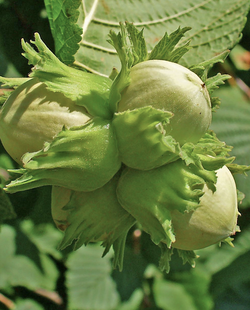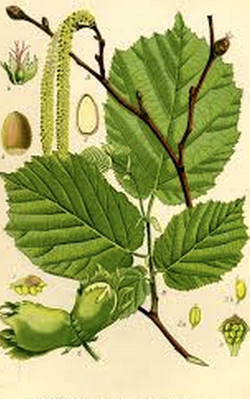 Corylus spp. (here avellana), hazel Corylus spp. (here avellana), hazel We can think of at least 180 great forest garden & perennial crops for cold climate Sweden. Want to hear about them? Over the course of the next year we will profile 5 a week on the blog. Perennial plants and crops offer a low energy, oil & resource input based foundation for future-proof agricultures. By default if an agriculture is to be called regenerative the bottom line is that it must be soil building, not soil depleting. Relentless deep tillage & poor soil husbandry (wifery?!) contributes to the majority of the 24 billion tons of topsoil lost every year on planet water. We are going to be focused on holistic polyculture grazing and perennial production at ridgedale over most of the site as this represents the most effective way to restore our degraded landscape, produce high value produce and ensure the future resource base we are managing holistically for in our decision making.  Genus Corylus spp. Species canadensis Common Name hazel Form shrub or tree Habit clumping Origin Europe (avellana) Light sun to part Moisture mesic Edible nuts Whilst Corylus avellana is native here in Europe breeding work still needs to be done for our colder northern latitudes in our minds. It is well worth considering Eastern & central American species, including American Hazel and Beaked Hazel, linked below. Common hazel is typically a shrub reaching 3–8 m tall, but can reach 15 m in a tree form. The leaves are deciduous, rounded, 6–12 cm long and across, softly hairy on both surfaces, and with a double-serrate margin. The flowers are produced very early in spring, before the leaves, and are monoecious with single-sex wind-pollinated catkins. Male catkins are pale yellow and 5–12 cm long, while female catkins are very small and largely concealed in the buds with only the bright red 1–3 mm long styles visible. The fruit is a nut, produced in clusters of one to five together, each nut held in a short leafy involucre ("husk") which encloses about three quarters of the nut. The nut is roughly spherical to oval, 15–20 mm long and 12–20 mm broad (larger, up to 25 mm long, in some cultivated selections), yellow-brown with a pale scar at the base. The nut falls out of the involucre when ripe, about 7–8 months after pollination. It is readily distinguished from the closely related filbert (Corylus maxima) by the short involucre; in the filbert the nut is fully enclosed by a beak-like involucre longer than the nut. Seed is eaten raw or roasted and used in breads, cakes, biscuits, sweets, etc. An excellent nut for raw eating. They can also be liquidized and used as a milk. The nuts are rich in oil. The seed ripens in mid to late autumn and will need to be protected from squirrels if present. When kept in a cool place, and not shelled, the seed should store for at least 12 months. A clear yellow edible oil is obtained from the seed. It is used in salad dressings, baking etc. The seed contains up to 65% of a non-drying oil, used in paints, cosmetics, etc. The whole seed can be used to polish and oil wood. It is very easy to apply and produces a nice finish. The finely ground seeds are used as an ingredient of face masks in cosmetics. Plants can be grown as a tall hedge. They need to be left untrimmed or only lightly trimmed if seed is required. The bark and leaves are a source of tannin. Wood is soft, easy to split, not very durable but beautifully veined. Used for inlay work, small items of furniture, hurdles, wattles, basketry, pea sticks, etc. The wood also yields a good quality charcoal, used by artists. OUR FRIENDS AT PFAF HAVE AN AMAZING DATABASE OF SPECIES (UK BASED);Corylus avellana (Common European Hazel)
Corylus maxima (Filbert cultivar) Corylus cornuta (Beaked Hazel) Corylus americana (American Hazel)
2 Comments
24/1/2014 08:27:03 pm
There is a another serious competitor for the nuts: Nötviveln. Se http://www.nt.se/arkiv/2004/11/04/Reportage/1978896/N%F6tviveln-t%F6mmer-hassel-n%F6tterna.aspx
Reply
ridgedale Richard
24/1/2014 08:50:55 pm
Thanks Daniel,
Reply
Leave a Reply. |
Details
Like us on FB Below for regular updatesStay up to date with customized updates you want to receive
Upcoming coursesArchives
December 2016
Categories
All
|

 RSS Feed
RSS Feed